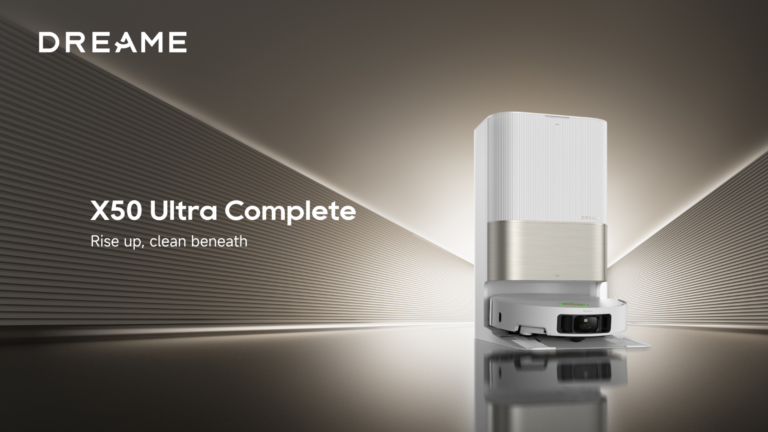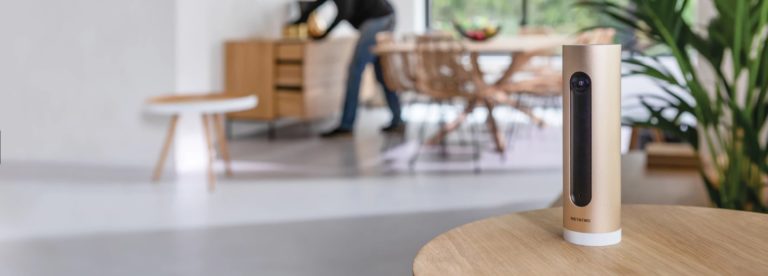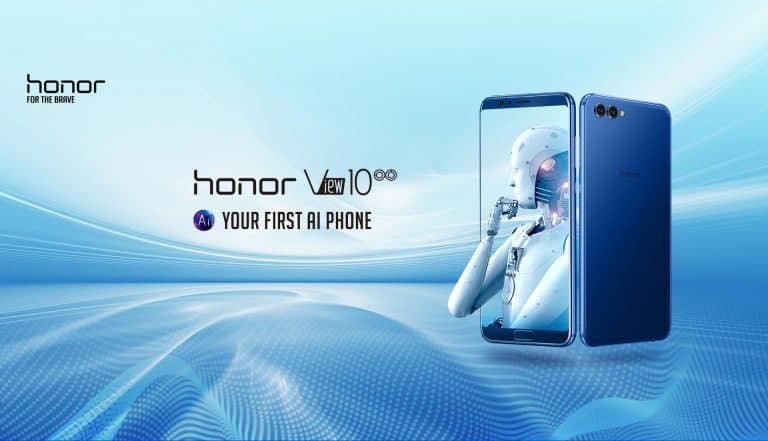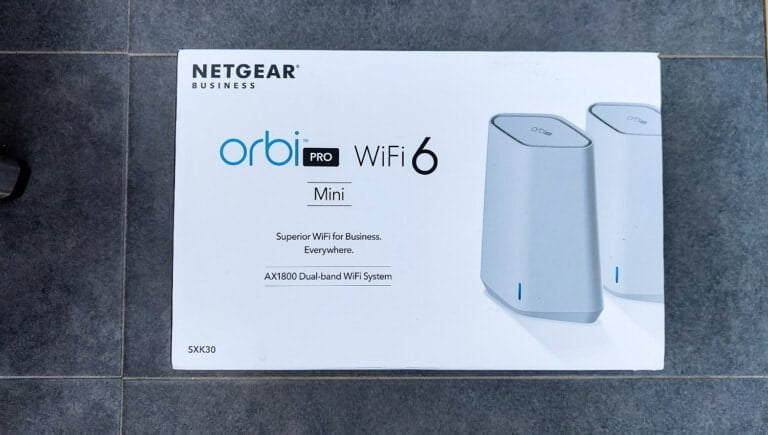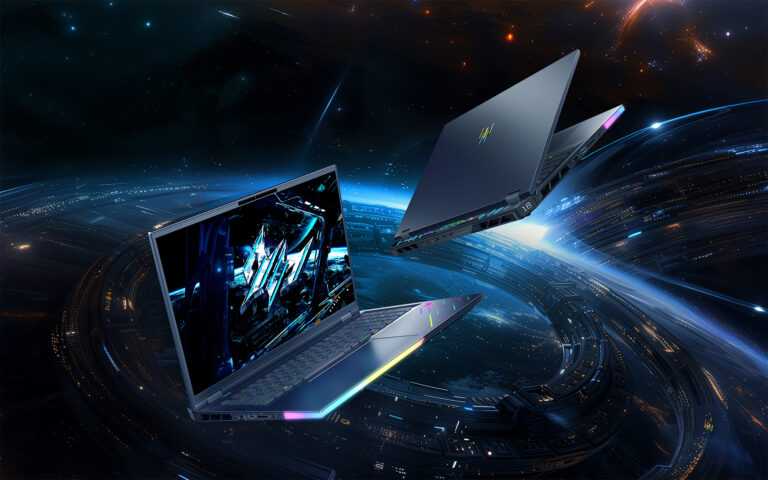Any links to online stores should be assumed to be affiliates. The company or PR agency provides all or most review samples. They have no control over my content, and I provide my honest opinion.
When I reviewed the Xiaomi Mi 11 at the start of the year, I had some concerns over sustained performance with high loads and battery life. This issue was then reflected with the Samsung Galaxy S21 Ultra and its Exynos 2100 chipset.
While both chipsets are incredibly powerful, it seemed like the introduction of the new powerful Arm Cortex X1 came at the cost of efficiency.
Now that the OnePlus 9 Pro is out, how does that compare with overall performance and does it suffer from the same issues with performance drops and quick battery drain?
OnePlus 9 Pro vs Xiaomi Mi 11 & Samsung Galaxy S21 Ultra Antutu Benchmarks
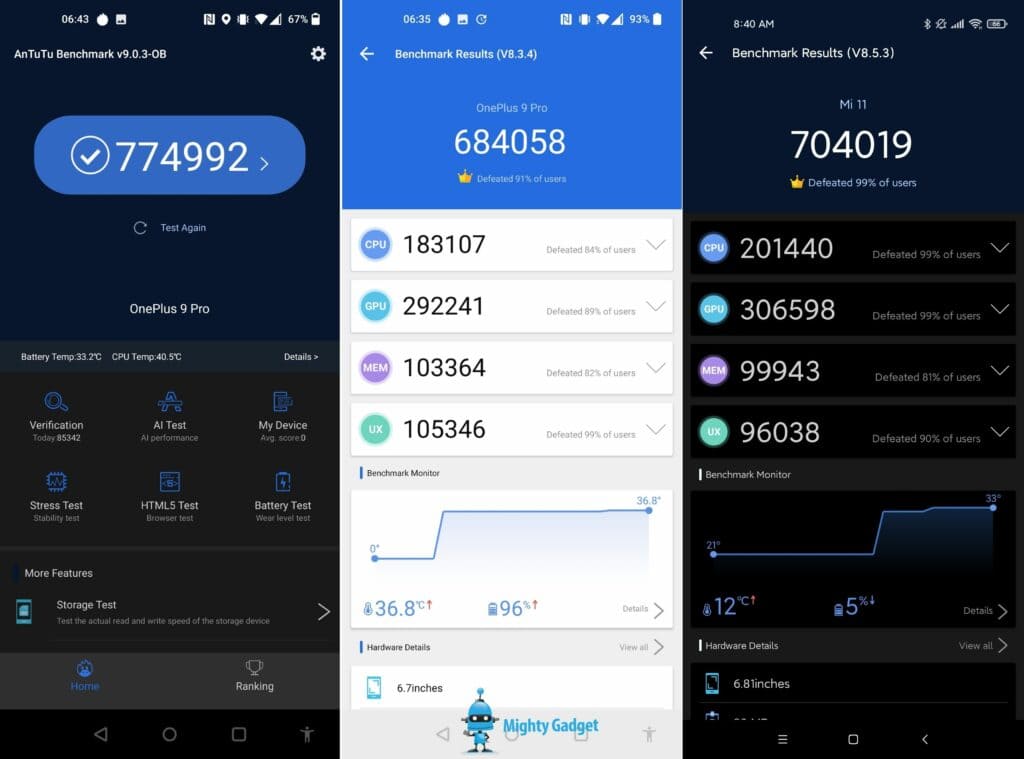
| Total | CPU | GPU | MEM | UX | Temp Increase | Battery Decrease | |
|---|---|---|---|---|---|---|---|
| Honor Magic5 Pro | 1092857 | 204878 | 540192 | 201695 | 146092 | 8 | 4 |
| Honor Magic4 Pro | 938464 | 197169 | 440631 | 148260 | 152404 | 10.7 | 5 |
| OPPO Find X5 Pro | 842660 | 166408 | 435209 | 111466 | 129577 | 7.5 | 5 |
| OPPO Find X3 Pro | 777229 | 192437 | 300378 | 137073 | 147341 |
Annoyingly Antutu is now on its 9th version, and any v9 result is not comparable to v8.
This scores considerably higher than the Xiaomi Mi 11 & Samsung Galaxy S21 Ultra in v9, which were tested using V8.
In version 9, the OnePlus scores 774992, in V8 it achieves 684085, a 13% difference.
The V8 results put the OnePlus 9 Pro behind the Xiaomi Mi 11 by between 1% and 3%. The warming temperatures during testing could attribute to this.
OnePlus 9 Pro vs Xiaomi Mi 11 & Samsung Galaxy S21 Ultra Geekbench
| Geekbench 5 | Chipset | Single Core | Multi Core |
|---|---|---|---|
| Honor Magic5 Pro | Snapdragon 8 Gen 2 | 1481 | 4932 |
| Honor Magic4 Pro | Snapdragon 8 Gen 1 | 1220 | 3569 |
| Xiaomi Mi 11 | Snapdragon 888 | 1139 | 3693 |
| OnePlus 9 Pro | Snapdragon 888 | 1109 | 3487 |
| Samsung Galaxy S21 Ultra | Exynos 2100 | 1079 | 3381 |
| Google Pixel 6 | Google Tensor | 1042 | 2957 |
| Xiaomi | Dimensity 8200-Ultra | 1005 | 3744 |
| OPPO Find X5 Pro | Snapdragon 8 Gen 1 | 976 | 3484 |
| Asus ROG Phone 3 S | Snapdragon 865+ | 975 | 3357 |
| Realme GT Neo 3 | Dimensity 8100 | 966 | 3672 |
| OPPO Find X3 Pro | Snapdragon 888 | 928 | 3357 |
| Realme X50 Pro | Snapdragon 865 | 910 | 3205 |
| Infinix Note 30 VIP | Dimensity 8050 | 854 | 3047 |
| Redmi K30 Ultra | Dimensity 1000+ | 782 | 2890 |
| Samsung Galaxy S20 | Exynos 990 | 772 | 2590 |
Geekbench offers predictable results, which is very similar to the Mi 11, which the S21 sits a little behind.
OnePlus 9 Pro vs Xiaomi Mi 11 & Samsung Galaxy S21 Ultra PCMark
| Performance Score | Work 3.0 Battery | |
|---|---|---|
| Honor Magic5 Pro | 14310 | 13h 38 mins |
| Honor Magic4 Pro | 14670 | 10h 32 mins |
| Samsung Galaxy S21 Ultra Exynos 2100 | 13638 | 12h 46min |
| Pixel 8 Pro | 12091 | 12 hours 56 mins |
| OPPO Find X3 Pro | 11932 | 9 hours |
| Pixel 7 Pro Tensor G2 | 11550 | 11h 39min |
| Pixel 6 Tensor | 11443 | 9h 45min |
The PCMark performance score is excellent, sitting 17% higher than the Xiaomi Mi 11, but well below the S21. I wouldn’t worry about the exact score, any of these phones offers above and beyond any needs for performance.
OnePlus 9 Pro vs Xiaomi Mi 11 & Samsung Galaxy S21 Ultra PCMark Battery Test
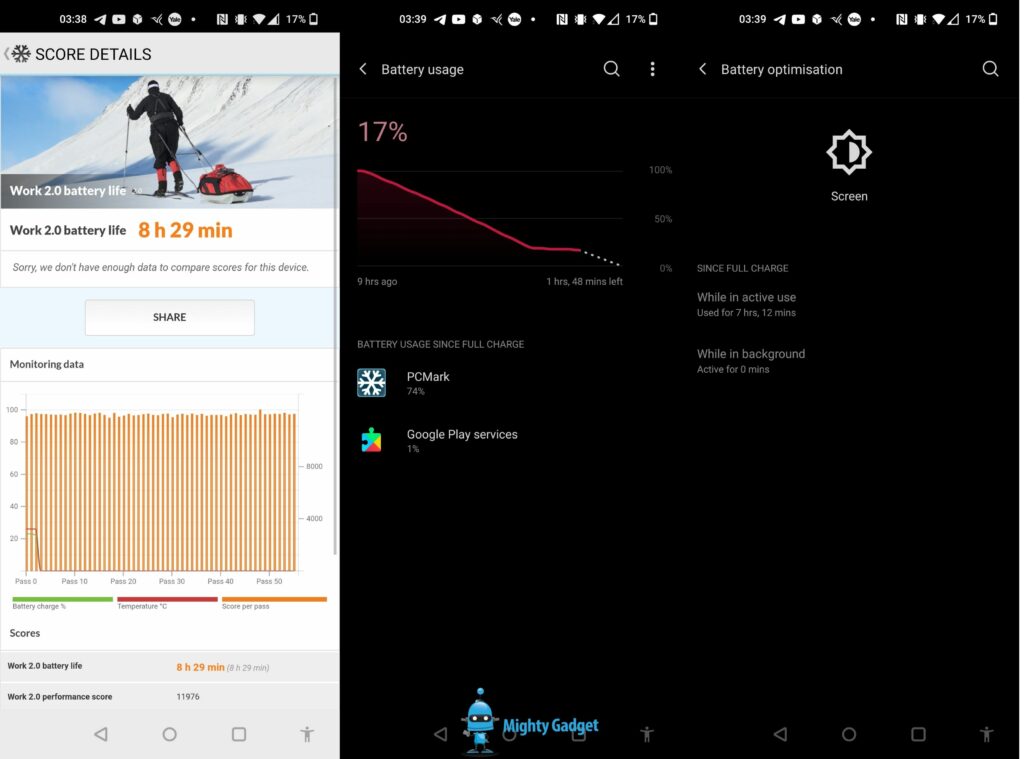
The PCMark Battery Test was not good for the OnePlus 9 Pro, with one of the lowest results I have seen in the past year and lower than both the S21 and Mi 11.
It is too early to give a definitive opinion about the battery, since using the phone it last OK, it is not like phones used to be years ago where I am charging it mid-day, but it is certainly not as good as I am used to.
The higher score per run vs the Xiaomi Mi 11 is likely to blame for the lower battery performance. Each company will optimise the OS for different usage scenarios, so the OP9Pro seems to be favouring performance during general use.
OnePlus 9 Pro vs Xiaomi Mi 11 & Samsung Galaxy S21 Ultra 3D Mark
| Chipset | Sling Shot Extreme OpenGL | Sling Shot Extreme Vulcan | Wild Life | |
|---|---|---|---|---|
| OnePlus 9 Pro | Snapdragon 888 | Maxed Out | Maxed Out | 5775 |
| Samsung Galaxy S21 Ultra | Exynos 2100 | 7736 | 6467 | 5741 |
| Xiaomi Mi 11 | Snapdragon 888 | 8274 | 8182 | 5663 |
| Huawei Mate 40 Pro | Kirin 9000 | 9168 | 8401 | 5976 |
| Asus ROG Phone 3 | Snapdragon 865+ | 7645 | 7002 | 4127 |
| Realme X50 Pro | Snapdragon 865 | 3791 | ||
| Black Shark 3 | Snapdragon 865 | 7215 | 6606 | |
| Redmi K30 Ultra | Dimensity 1000+ | 6614 | 6143 | |
| OnePlus 7T | Snapdragon 855+ | 6278 | 5504 | |
| Black Shark | Snapdragon 855 | 5791 | 5030 |
The normal 3DMark tests also have some issues; using Sling Shot Extreme, the OP9Pro gets a result of maxed out. I am unsure if this is a result that has always been possible or if 3Dmark have updated the app so that it actively pushes people to use Wild Life.
In Wild Life, the OnePlus 9 Pro scores the highest result of the three phones, with 5775, that’s 0.59% and 1.98% higher than the Samsung Galaxy S21 Ultra and Xiaomi Mi 11, respectively. This isn’t quite as high as the reported scores of the Huawei Mate 40 Pro.
These scores show just how much more power the Snapdragon 888 has compared to last years SD865 and is a good clue as to why the SD888 has an issue with battery and throttling.
The OP9Pro scores 52.33% higher than the Realme X50 Pro (SD865) in Wild Life.
OnePlus 9 Pro vs Xiaomi Mi 11 & Samsung Galaxy S21 Ultra 3DMark Stress Test
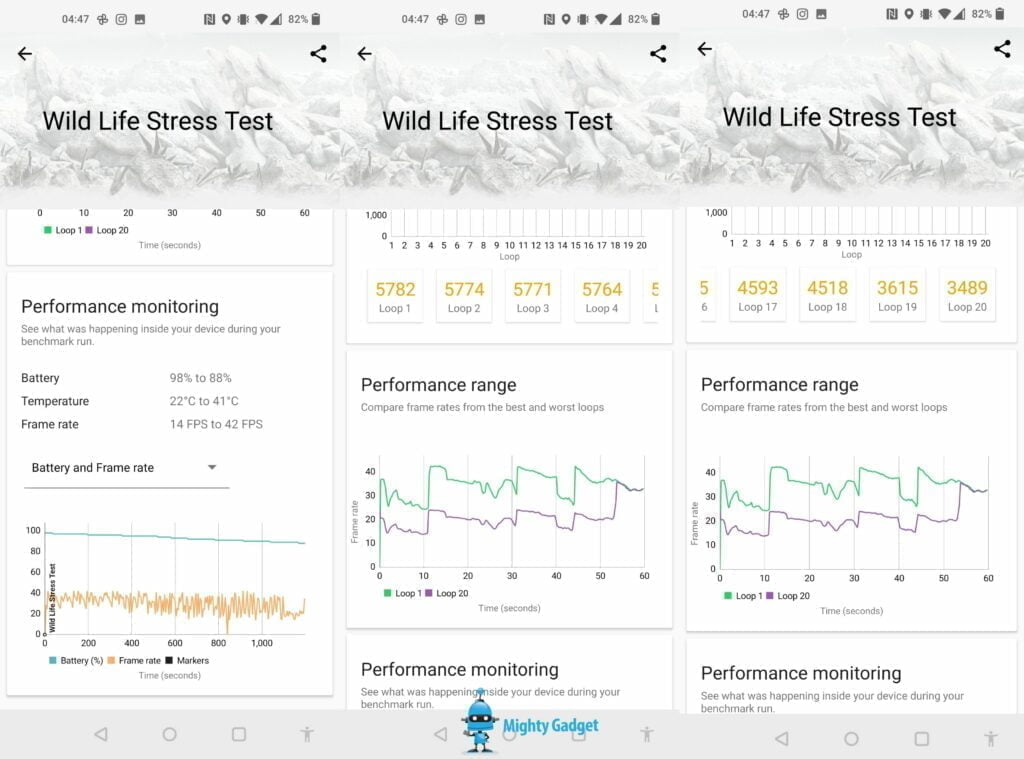
This is the main test that showed the issues faced with these two new powerful chipsets, and as expected, the OnePlus 9 Pro suffers the same problem.
At the start of the stress test, the OnePlus achieves a score of 5782, but this drops down to just 3489, giving it a stability score of 60.3%. Even performing at its worst with full throttling, the SD888 offers similar performance to the SD865.
The battery on the OnePlus dropped the least out of the three phones going from 98% to 88%..
This is considerably worse than the stability of the Xiaomi Mi 11, which started at 5550 and dropped to 5045, giving 90.9% stability. This suffered from a 15 digit drop in the battery.
However, that was tested in January when my office was very cold. The phone started off at 24°C and increased to 46°C.
The Samsung Galaxy S21 Ultra had the same poor stability levels as the OP9Pro at just 62%, with its score going from 5466 to 3404 over the tests. It’s temperature went from 25°C to 43°C with a 12 digit drop in the battery
Overall
The results are certainly not what I would call ideal. However, it would seem that the OEMs are not to blame here. The performance drops, battery drain and high temperatures are almost certainly chipset related.
It could be the Samsung 5nm fabrication process, but it is more likely the new ARM Cortex-X1. This new CPU design is literally marketed as a “performance first design” implying it sacrifices power management in favour of performance.
So, the takeaway from this is that you can expect every single Qualcomm Snapdragon 888 (and Exynos 2100) based phone to suffer from higher than normal battery drain and throttling under load.
65W charging somewhat makes up for a poor battery
It is not the end of the world though, all three phones comfortable make it through to the end of the day as long as you don’t spend a significant time gaming. They all offer fast charging too, in particular, the Mi 11 has 55W/50W wired/wireless, and the OP9Pro has 65W/50W, so topping them up on high use days takes just a few minutes.
Alternative options to the Qualcomm Snapdragon 888 & Exynos 2100
If that is not acceptable to you, it means you may have to look at none premium flagship devices this year. There are going to be plenty of options, the new Qualcomm Snapdragon 780G looks like it could be the perfect chipset for someone looking for high performance and efficiency, and the new MediaTek Dimensity 1200 chipset should also compare well. Then you have the SD870, which is a supped up SD865+.
One issue with opting for a lower specced chipset is that the camera spec may also reduce; having a high-quality camera is the main reason why I opted for the OnePlus 9 Pro.
We will have to wait and see what other brands offer over the next few months. The Google Pixel 6 seems like a good candidate to use the SD780G while offering incredible camera performance. OPPO also offer superb camera performance with lower specced chipsets with the Reno series, e.g. Reno4 Pro). We have also seen Realme and Xiaomi use the Samsung 108 HM2 on their sub-£300 phones.
I am James, a UK-based tech enthusiast and the Editor and Owner of Mighty Gadget, which I’ve proudly run since 2007. Passionate about all things technology, my expertise spans from computers and networking to mobile, wearables, and smart home devices.
As a fitness fanatic who loves running and cycling, I also have a keen interest in fitness-related technology, and I take every opportunity to cover this niche on my blog. My diverse interests allow me to bring a unique perspective to tech blogging, merging lifestyle, fitness, and the latest tech trends.
In my academic pursuits, I earned a BSc in Information Systems Design from UCLAN, before advancing my learning with a Master’s Degree in Computing. This advanced study also included Cisco CCNA accreditation, further demonstrating my commitment to understanding and staying ahead of the technology curve.
I’m proud to share that Vuelio has consistently ranked Mighty Gadget as one of the top technology blogs in the UK. With my dedication to technology and drive to share my insights, I aim to continue providing my readers with engaging and informative content.


